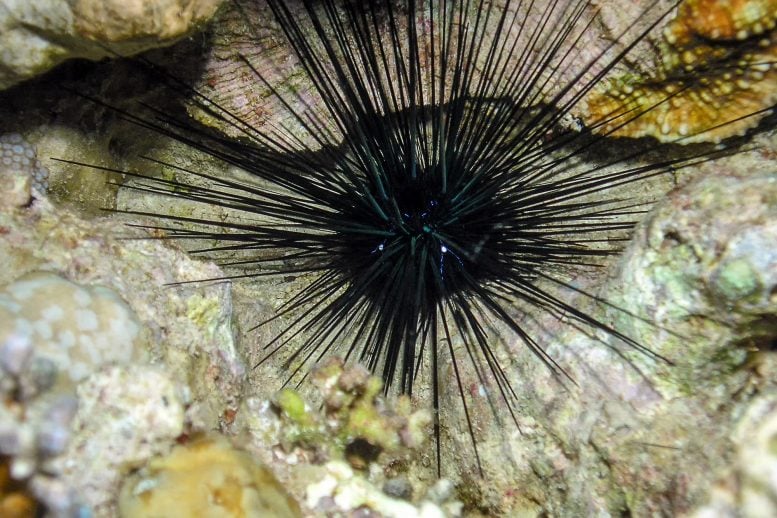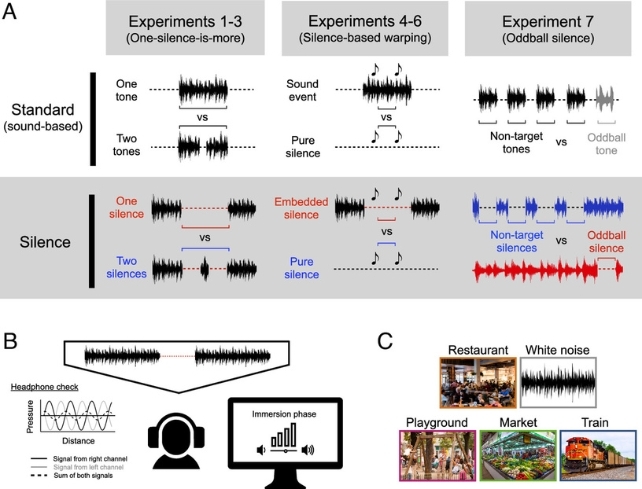
Ένας μονοκύτταρος οργανισμός, ο scuticociliate, έχει αναγνωριστεί ως η αιτία του μαζικού θανάτου το 2022 αχινών με μακριά ράχη στην Καραϊβική και την ανατολική ακτή της Φλόριντα. Αυτοί οι αχινοί είναι απαραίτητοι για την υγεία των κοραλλιογενών υφάλων και η ανακάλυψη εγείρει ερωτήματα σχετικά με την παρουσία των βλεφαρίδων, τις συνθήκες ανάπτυξής τους και τον πιθανό αντίκτυπό τους σε άλλα είδη. Φωτογραφία του μακρύ, αγκαθωτό αχινό (Diadema antillarum).
Η αιτία του μαζικού θανάτου των αχινών με μακροβούτια – μια απώλεια που απειλεί την υγεία των κοραλλιογενών υφάλων από την Καραϊβική Θάλασσα έως την ανατολική ακτή της Φλόριντα – προκλήθηκε από έναν μονοκύτταρο οργανισμό που ονομάζεται βλεφαροειδής.
Το κυνήγι ενός δολοφόνου ολοκληρώθηκε το 2022 που εξαφάνισε αχινούς με μακριά ράχη στην Καραϊβική και κατά μήκος της ανατολικής ακτής της Φλόριντα. Μια ομάδα ερευνητών που οργανώθηκε από τη Mia Breitbart, διακεκριμένη καθηγήτρια Πανεπιστημίου στο Κολλέγιο Θαλάσσιων Επιστημών του Πανεπιστημίου της Νότιας Φλόριντα, εντόπισε έναν μονοκύτταρο οργανισμό που ονομάζεται ακτινωτός ως την αιτία μαζικού θανάτου ενός θαλάσσιου ζώου ζωτικής σημασίας για την υγεία των κοραλλιογενών υφάλων.
Τα ευρήματά τους δημοσιεύονται στις 19 Απριλίου στο περιοδικό Nature
Ciliate culture viewed under the microscope. Credit: Mya Breitbart USF College of Marine Science
“We’re beyond thrilled to get to the bottom of the 2022 mystery and a bit stunned we did it so quickly,” said Breitbart, senior author on the Science Advances study and an expert in marine genomics. “We had a great team in place and the tools needed to do the ocean science equivalent of a forensic investigation.”
Ciliates are microscopic organisms covered in hair-like structures called cilia that help them move and eat. They are found almost anywhere there is water and most are not disease-causing agents. However, this specific species of ciliate – called a scuticociliate – has been implicated in die-offs of other marine species, such as sharks, in the past.

Photo compilation showing the same sea urchin before and after infection with the ciliate in the USF aquarium research facility. Credit: Makenzie Kerr USF College of Marine Science
Examining urchins collected from 23 sites in the Caribbean, the research team used a series of techniques to confirm the source of the die-off event.
After identifying the ciliate in every affected urchin specimen using genomic techniques, the team grew ciliates in the lab and performed infection experiments at the USF College of Marine Science. When the pathogen was introduced to otherwise healthy urchins in an aquarium tank, the urchins died within a few days – replicating what was taking place in the ocean and confirming the ciliate as the disease source.

DaSc-affected sea urchin, Aruba, August 2022. Credit: Ian Hewson Cornell University
“We’re excited to share this information with everyone, from reef managers to additional scientists so we can explore it further and try to stop its spread,” Breitbart said.

Mya Breitbart (USF) viewing the ciliate culture by microscopy. Credit: Makenzie Kerr USF College of Marine Science
The long-spined sea urchins inhabit shallow tropical waters and feed on algae that would otherwise destroy a reef. They began to lose their spines within days of contracting an unknown disease and died in droves starting in January 2022.
A similar die-off event took place in the early 1980s, which wiped out 98 percent of the long-spined sea urchin population. The culprit of that die-off remains a mystery.
Breitbart first got the call about the unfolding die-off at the end of March 2022. She immediately assembled a team consisting of Ian Hewson, lead author on the publication and a marine ecologist at Cornell University; Christina Kellogg, a microbiologist from the U.S. Geological Survey in St. Petersburg, Fla. who has worked extensively on coral reef diseases; and USF graduate student Isabella Ritchie.
“At the time, we didn’t know if this die-off was caused by pollution, stress, something else – we just didn’t know,” said Hewson, an expert in diseases that cause mass die-offs of sea stars, who flew from New York to the Caribbean Islands to observe the situation.
Even with the source of the mysterious die-off uncovered, questions still remain. For example:
- Is this ciliate new to the area, or was it there prior to the die-off?
- If it has been there, what environmental conditions favored its growth and why did it infect the urchins?
- Can it affect other species of urchins?
«Μια θεωρία που έχουμε είναι ότι το βλεφαριδικό αναπτύχθηκε καλά κάτω από τις συνθήκες υψηλής παραγωγικότητας που παρατηρήθηκαν στην Καραϊβική όταν άρχισε να ξεθωριάζει», είπε ο Kellogg. “Είμαστε επίσης περίεργοι για το γεγονός ότι υπάρχει κάποια επικάλυψη σε ορισμένες από τις γεωγραφικές περιοχές όπου συνέβη αυτή η εξαφάνιση και όπου οι κοραλλιογενείς ύφαλοι μειώνονται λόγω της νόσου της απώλειας ιστού των πετρών των κοραλλιών.”
Αναφορά: «Scuticocylate Agent Causes Mass Mortality of Diadema Antillarum in the Caribbean Sea» Από τους Ian Hewson, Isabella T Ritchie, James S Evans, Ashley Alterra, Donald Berenger, Irene Bowman, Marilyn Brandt, Kayla A. Budd και Rolio A. Camacho, Thomas O. Cornwell, Peter D. Kimani A. Kitson-Walters, Patricia Kramer, Judith C.Lang, Harilaos Lessios, Lauren Liddy, David Marancik, Stephen Nimrod, Joshua T. Patterson, Marit Pistor, Isabel C. Romero, Rita Sellares-Blasco, Moriah LB Sevier Sharp, Matthew Souza, Andrina Valdez-Trinidad, Maren van der Laan, Brian Villanova-Cuevas, Maria Villalpando, Sarah de Von Huene, Matthew Warham, Tom Weyers, Stacy M. Yanong, Soumira Zambrano, Alise Zimmerman, Mia Breitbart 19 Απριλίου 2023 Διαθέσιμο εδώ. Η επιστήμη προχωρά.
DOI: 10.1126/sciadv.adg3200
Η έρευνα χρηματοδοτήθηκε από το Εθνικό Ίδρυμα Επιστημών, το Atkinson Rapid Response Center for Sustainable Futures, AGGRA, την Εθνική Υπηρεσία Ωκεανών και Ατμόσφαιρας, το Εθνικό Ίδρυμα Ψαριών και Άγριας Ζωής, το Florida Keys Marine Preserve και την Επιτροπή Ψαριών και Άγριας Ζωής της Φλόριντα.





